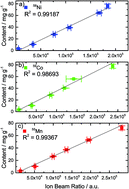当前位置:
X-MOL 学术
›
J. Anal. At. Spectrom.
›
论文详情
Our official English website, www.x-mol.net, welcomes your
feedback! (Note: you will need to create a separate account there.)
Matrix-matched standards for the quantification of elemental lithium ion battery degradation products deposited on carbonaceous negative electrodes using pulsed-glow discharge-sector field-mass spectrometry
Journal of Analytical Atomic Spectrometry ( IF 3.1 ) Pub Date : 2017-08-17 00:00:00 , DOI: 10.1039/c7ja00129k Marco Evertz 1, 2, 3, 4 , Timo Schwieters 1, 2, 3, 4 , Markus Börner 1, 2, 3, 4 , Martin Winter 1, 2, 3, 4, 5 , Sascha Nowak 1, 2, 3, 4
Journal of Analytical Atomic Spectrometry ( IF 3.1 ) Pub Date : 2017-08-17 00:00:00 , DOI: 10.1039/c7ja00129k Marco Evertz 1, 2, 3, 4 , Timo Schwieters 1, 2, 3, 4 , Markus Börner 1, 2, 3, 4 , Martin Winter 1, 2, 3, 4, 5 , Sascha Nowak 1, 2, 3, 4
Affiliation

|
In this work an external calibration approach for glow discharge-sector field-mass spectrometry (GD-SF-MS) using matrix-matched self-prepared carbonaceous standards for elemental battery degradation products of LiNi1/3Co1/3Mn1/3O2 (NCM111) positive electrodes like lithium, manganese, cobalt and nickel is adapted. Firstly, the standards were prepared using graphite mixed with increasing contents of NCM111 which was coated on a thin copper foil as a current collector. The homogeneous distribution of NCM111 in the standards was proven via SEM/EDX images and the bulk homogeneity of the electrode sheets was validated via ICP-OES. Afterwards, sufficient linearity could be obtained in a calibration range of 1 mg g−1 to 28 mg g−1 for 7Li with respect to the active material mass. Additionally, the matrix-matched relative sensitivity factors (RSFs) of each element could be calculated. Limits of detection (LODs) ranging from 80 μg g−1 (7Li) up to 393 μg g−1 (58Ni) could be achieved at low (R > 300) and medium (R > 4000) resolutions for the Element GD, respectively. Secondly, we adapted the matrix-matched RSF values in order to investigate cycled electrodes by monitoring the 7Li signal as well as common isotopes from lithium ion batteries – such as 31P and 19F, originating from the conducting salt – and transition metals to conduct depth-resolved analysis. The concentration of transition metals in all of the cycled electrodes was below the LOD of the GD-SF-MS method which was investigated in a previous study, showing a maximum bulk deposition of transition metals of 4.5 mg g−1. As expected, an accumulation of 7Li in the first few minutes (=surface layers) of sputtering was observed in the cycled carbonaceous negative electrodes followed by a decreasing 7Li signal with ongoing sputtering indicating the presence of a solid electrolyte interphase (SEI) passivation layer.
中文翻译:

使用脉冲辉光放电扇形场质谱法定量分析沉积在碳质负极上的元素锂离子电池降解产物的基质匹配标准品
在这项工作中,使用矩阵匹配的自行制备的碳质标样对LiNi 1/3 Co 1/3 Mn 1/3的元素电池降解产物进行的辉光放电扇区场质谱(GD-SF-MS)的外部校准方法可以使用O 2(NCM111)正极,例如锂,锰,钴和镍。首先,使用混合了含量不断增加的NCM111的石墨制备标准液,然后将其涂覆在薄铜箔上作为集电器。NCM111在标准均匀分布被证明通过SEM / EDX图像和所述电极板的散装均一性进行了验证通过ICP-OES。然后,充分的线性可在1毫克g的校准范围获得-1至28毫克克-1为7相对于活性物质的质量李。此外,可以计算每个元素的矩阵匹配相对灵敏度因子(RSF)。对于GD元素,在低(R > 300)和中(R > 4000)分辨率下,检测限(LOD)可以达到80μgg -1(7 Li)至393μgg -1(58 Ni)。, 分别。其次,我们通过监测7个电极来适应矩阵匹配的RSF值,以便研究循环电极。Li信号以及锂离子电池中常见的同位素(例如31 P和19 F,其源自导电盐)和过渡金属进行深度解析。所有循环电极中过渡金属的浓度均低于先前研究中研究的GD-SF-MS方法的检测限,显示最大过渡金属堆积量为4.5 mg g -1。正如预期的那样,在循环的含碳负电极中观察到溅射的最初几分钟(=表面层)中累积了7 Li,随后在进行中的溅射过程中7 Li信号下降,表明存在固态电解质中间相(SEI)钝化层。
更新日期:2017-09-05
中文翻译:

使用脉冲辉光放电扇形场质谱法定量分析沉积在碳质负极上的元素锂离子电池降解产物的基质匹配标准品
在这项工作中,使用矩阵匹配的自行制备的碳质标样对LiNi 1/3 Co 1/3 Mn 1/3的元素电池降解产物进行的辉光放电扇区场质谱(GD-SF-MS)的外部校准方法可以使用O 2(NCM111)正极,例如锂,锰,钴和镍。首先,使用混合了含量不断增加的NCM111的石墨制备标准液,然后将其涂覆在薄铜箔上作为集电器。NCM111在标准均匀分布被证明通过SEM / EDX图像和所述电极板的散装均一性进行了验证通过ICP-OES。然后,充分的线性可在1毫克g的校准范围获得-1至28毫克克-1为7相对于活性物质的质量李。此外,可以计算每个元素的矩阵匹配相对灵敏度因子(RSF)。对于GD元素,在低(R > 300)和中(R > 4000)分辨率下,检测限(LOD)可以达到80μgg -1(7 Li)至393μgg -1(58 Ni)。, 分别。其次,我们通过监测7个电极来适应矩阵匹配的RSF值,以便研究循环电极。Li信号以及锂离子电池中常见的同位素(例如31 P和19 F,其源自导电盐)和过渡金属进行深度解析。所有循环电极中过渡金属的浓度均低于先前研究中研究的GD-SF-MS方法的检测限,显示最大过渡金属堆积量为4.5 mg g -1。正如预期的那样,在循环的含碳负电极中观察到溅射的最初几分钟(=表面层)中累积了7 Li,随后在进行中的溅射过程中7 Li信号下降,表明存在固态电解质中间相(SEI)钝化层。











































 京公网安备 11010802027423号
京公网安备 11010802027423号